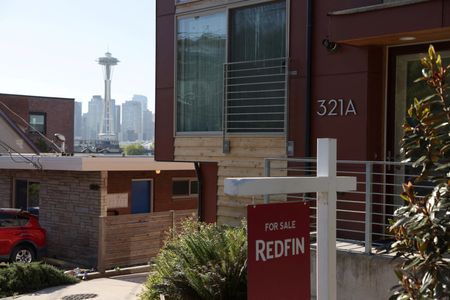
WASHINGTON (Reuters) – U.S. existing home sales tumbled to a two-year low in May as prices jumped to a record high – topping the $400,000 mark for the first time – and as mortgage interest rates increased further, sidelining first-time buyers from the market.
Existing home sales fell 3.4% to a seasonally adjusted annual rate of 5.41 million units last month, the lowest level since June 2020 when sales were rebounding from the COVID-19 lockdown slump, the National Association of Realtors said on Tuesday. It was the fourth straight monthly sales decline.
Economists polled by Reuters had forecast sales decreasing to a rate of 5.40 million units. Sales rose in the Northeast, but fell in the Midwest, the West and densely populated South.
Home resales, which account for the bulk of U.S. home sales, tumbled dropped 8.6% on a year-on-year basis.
May’s sales were mostly closings on contracts signed one to two months ago before mortgage rates started accelerating amid a surge in inflation expectations and aggressive interest rate hikes from the Federal Reserve.
The 30-year fixed-rate mortgage jumped 55 basis points last week to a 13-1/2-year high average of 5.78%, according to data from mortgage finance agency Freddie Mac. That was the largest one-week increase since 1987. The rate has surged more than 250 basis points since January.
The housing market, the sector most sensitive to interest rates, is losing speed. But this could help to bring housing supply and demand back into alignment and lower prices.
The median existing house price accelerated 14.8% from a year earlier to an all-time high of $407,600 in May. Sales remained concentrated in the upper-price end of the market amid a paucity of entry-level houses.
The NAR revised house prices going to 2021 after data for the West was incorrectly captured.
There were 1.16 million previously owned homes on the market, up 12.6% from April and down 4.1% from a year ago. With demand cooling, monthly supply is likely to continue steadily improving. The government reported last week that housing completions in May increased to the highest level since 2007, while the backlog of homes yet to be built hovered near record highs.
At May’s sales pace, it would take 2.6 months to exhaust the current inventory of existing homes, up from 2.5 months a year ago. A six-to-seven-month supply is viewed as a healthy balance between supply and demand.
Properties typically remained on the market for 16 days First-time buyers accounted for 27% of sales. All-cash sales made up 25% of transactions.
(Reporting by Lucia Mutikani; Editing by Dan Burns)

